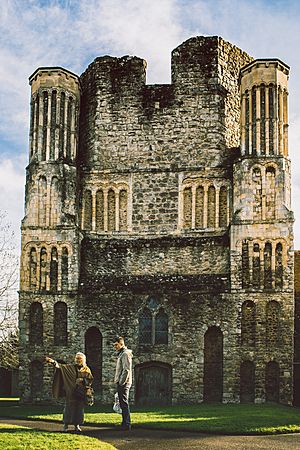Malling Abbey facts for kids
St Mary's Abbey, also known as Malling Abbey, is a special place where Anglican Benedictine nuns live. It is located in West Malling, Kent, England. The nuns follow a way of life focused on prayer, work, and community.
A Look Back in Time
The land where Malling Abbey stands was first given to the church in 946 by King Edmund I. Later, around 1090, Gundulf, who was the Bishop of Rochester, decided to build a monastery for Benedictine nuns here. This was one of the first monasteries for women built after the Norman Conquest.
The first abbess, Avicia, was appointed just before Bishop Gundulf died in 1108. The abbey received land from Bishop Gundulf and Archbishop Anselm. They also got special rights from the King, like holding weekly markets and annual fairs. These gifts and rights helped the abbey become wealthy.
As the abbey grew, West Malling became a busy market town. Over the centuries, the abbey faced challenges. A big fire in 1190 destroyed much of the abbey and the town. Later, in 1349, the Black Death greatly reduced the number of nuns.
A major change happened in 1538 during the Dissolution of the Monasteries. This was when King Henry VIII closed down many monasteries in England. The abbey was taken by the Crown on October 28, 1538. The nuns did not want to sign the papers to give up their home.
Before it was closed, Malling Abbey was quite rich. It had beautiful buildings, including a Norman church and a guest house. For the next 350 years, many different families owned the abbey, and the buildings slowly fell into ruin.
In the mid-1700s, a banker named Frazer Honeywood repaired some of the old buildings. Then, in 1892, Charlotte Boyd bought the property. She wanted to bring church life back to the abbey. She invited a group of Anglican Benedictine nuns to live there. This community later left Malling Abbey in 1911.
Malling Abbey Today
The current community of Anglican Benedictine nuns moved to Malling Abbey in 1916. They started in 1891 as a group helping the poor in London. Later, they felt called to a more contemplative life, focusing on prayer and quiet reflection. They moved to a village in Somerset before coming to the historic Malling Abbey. Here, they continue the tradition of Benedictine prayer, worship, work, study, and welcoming visitors.
Since 2016, St Augustine's College of Theology, a college for studying theology, has been located at the Abbey's St. Benedict's Centre.
What the Buildings Look Like
Not much of the original abbey building remains today. The tower is Norman for its first two levels, and then Early English style above that. Some parts of the old church are still standing, including one of the transepts (a part of the church that crosses the main body) and a wall of the nave (the main part of the church). The refectory, where the nuns ate, is also still there. The cloisters, which are covered walkways around a courtyard, were rebuilt in the 1300s. The community also uses a newer abbey church built in 1966.


